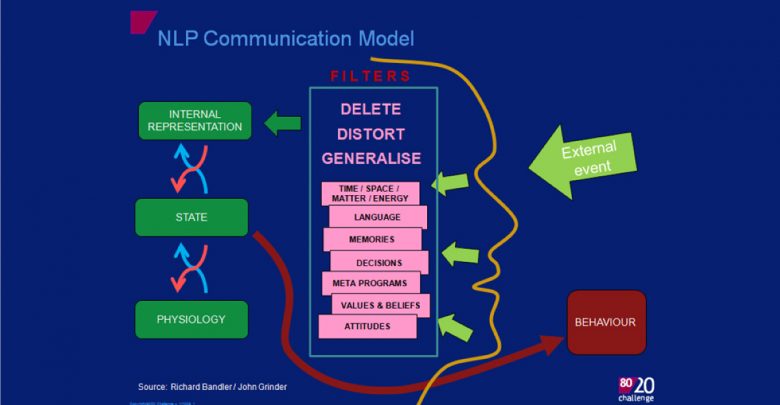NLP Theory of Communication
What is affecting our ability to listen and to really hear what others are saying? In what ways might our own brain be preventing us from getting the message someone else is trying to give? How can we minimize the distortions and get as pure message as possible, the way it was intended by the one giving it?

Why did I choose this tool? Neuro Linguistic Programming is often used as a method of changing behavior and subconscious programming. I don’t always favor this approach because I believe that change should be conscious as much as possible and that we should be in control of how and when we change something. Of course, in order to change anything, the first step is to understand it. This is where I have found NLP to be most helpful, as a support in becoming aware of what may be happening in our minds or the minds of others when we think communication/listening is taking place. It also sheds light on why we can have so many different interpretations of the same thing, and why even when we think that someone is listening, we later understand that they understood something completely different than what we actually intended to say. By becoming aware of these mental mechanisms that can be at play, we then have the ability to manage them better and as a result become better listeners and better communicators.
How does this apply to being a trainer? Training is all about communication. Understanding how the messages we are sending to participants, as well as the ones we are receiving from them can be interpreted is essential for clarity, accuracy and a clear understanding of what is going on. It can also help us to better understand participants and the reasons why they could be saying or feeling something, and that it’s not always because of us. A participant who thinks everything about the training is negative is probably being more influenced by their own filters then by the actual training experience, so we don’t need to take it personally (and the same can be true for the overly positive).
As the Turkish proverb by Mevlana goes, “Sen ne söylersen söyle, söylediğin, karşındakinin anladığı kadardır!” which we can translate as “Say whatever you want, but whatever you say means only as much as the other person understands.”
Main content:
What is NLP?
Neuro Linguistic Programming (NLP) began as a model of how we communicate with ourselves and others which was developed by Richard Bandler and John Grinder. This model explains how we process the information that comes to us from the outside. The belief is that “The map is not the territory.” And so, the internal representations that we make about an outside event are not necessarily the event itself.
In other words, everything that is communicated to us, whether it is something we hear, see, smell, or experience, has already been filtered by our brain, and we have given it a certain meaning. After we have assigned it a meaning (normally in a split second and without even our conscious consideration) we then feel the emotion associated to it, and then respond accordingly.
Between the occurrence of the event and the assigning of meaning, we receive all the sensory impulses available to support the process of creating the meaning. These include:
Visual
Including the sights we see or the way someone looks at us;
Auditory
Including sounds, the words we hear and the way that people say those words to us;
Kinesthetic
Or external feelings which include the touch of someone or something, the pressure and texture;
Olfactory
Which is smell; and
Gustatory
Which is taste.
The external event is perceived through sensory input channels and it is filtered i.e. we process the event. As we process the event, we delete, distort, and generalize the information that comes in, according to any number of several elements that filter our perception.
Deletion:
Deletion occurs when we selectively pay attention to certain aspects of our experience and not others. We then overlook or omit others. Without deletion, we would be faced with much too much information to handle with our conscious mind.
Distortion:
Distortion occurs when we make shifts in our experience of sensory data by making misrepresentations of reality. In Eastern philosophy there is a well-known story of distortion in the rope versus snake analogy. A man walking along the road sees what he believes to be a snake and yells “SNAKE.” However, upon arriving at that place he is relieved as he discovers that what he sees is really only a piece of rope.
Generalization:
The third process is generalization, where we draw global conclusions based on one or two experiences. At its best, generalization is one of the ways that we learn, by taking the information we have and drawing broad conclusions about the meaning of the effect of those conclusions.
So, the question is, when two people have the same stimulus, why don’t they have the same response? The answer is, because we delete, distort, and generalize the information from the outside.
But how does our brain know what to delete, how to distort and in what way to generalize?
We delete, distort and generalize the information that comes in from our senses based on one or more of the following five filters: Meta Programs, belief systems, values, decisions, and memories.
Meta Programs:
Meta programs are mental processes, which manage, guide and direct other mental processes. It’s our overarching programming system, and in brief includes:
1. Toward or Away
2. External or Internal Frame of Reference
3. Sorting By Self or Sorting by Others
4. Matcher or Mis-matcher
5. Convincer Strategy
6. Possibility vs. Necessity
7. Independent, Cooperative and Proximity Working Styles
Values:
The next filter is ‘values’. They are essentially an evaluation filter. They are how we decide whether our actions are good or bad, or right or wrong.
Beliefs:
The next filter is ‘beliefs’. Beliefs are the presuppositions and generalizations that we have about the way the world is.
Memories:
Memories can either be conscious and clear or a subconscious association. In either case, it is a connection between an element from the present with an element from the past, provoking either negative or positive emotions based on what happened in the past.
Decisions:
The fifth element that is related to memories, is ‘decisions’ that we’ve made in the past. Decisions may create beliefs, or may just affect our perceptions through time. Although we may think of decisions as conscious choices, many of our decisions were made either unconsciously or at a very early age. As a result, they may be forgotten by our conscious mind, but still influencing our current actions.
Based on all of the above-mentioned elements, we can understand that even when we are truly making the effort to “actively listen”, our minds are still deleting, distorting and generalizing information to make it compatible with our decisions, memories, beliefs, values and meta-programs. Therefore, the best way to become a better listener is actually to become more aware of our own neuro-linguistic programming. In that way we can recognize when it might be interfering with our listening and communication, and then we can either take a step back from it momentarily or choose to transform it entirely.
The only way that our neuro-linguistic programming can control us is if we are not aware of it. Everything that we can bring to our awareness can be transformed. And even if we don’t want to transform it, being aware of it allows us to take distance from it temporarily in order to understand someone else’s message with as few distortions as possible.
“That which we do not bring to consciousness appears in our lives as fate.” – Carl Jung
Reflection questions:
What are my main meta-programs?
1. Toward or Away
2. External or Internal Frame of Reference
3. Sorting By Self or Sorting by Others NLP Meta-Program
4. Matcher or Mis-matcher NLP Meta-Program
5. Convincer Strategy NLP Meta-Program
6. Possibility vs. Necessity NLP Meta-Program
7. Independent, Cooperative and Proximity Working Styles NLP Meta-Program
For a more detailed description of the above NLP meta programs, check out: http://sourcesofinsight.com/seven-meta-programs-for-understanding-people/
What are my core values?
What are my main beliefs about myself, others and life in general?
What main memories, positive or negative, might be affecting the way that I understand things today?
What decisions might be affecting the way that I understand things today?
It is very likely that whatever you write at this moment won’t be comprehensive, as it takes time and willingness to understand our filters and how they might be influencing our minds and consequently our lives. However, if you get this process started, your mind will fill in the blanks and will bring things to your attention that would have previously gone unnoticed. It helps to keep a journal, and to write down whenever we learn something new about ourselves, or about why we think/act the way we do.
Exercises:
How to apply it in everyday life:
In order to evaluate yourself as a listener, you can ask the following questions to one or more people that are close to you and that you feel comfortable with:
Do you feel that I am a good listener?
Are there times when I distort, delete or generalize what you say without realizing it?
In what instances does that happen? And how does it make you feel?
Do you feel empathy when I listen to you?
Am I capable of just listening to you, without offering my own opinion or solution?
What do you think I can do in order to be an even better listener?
Naturally it’s important to really listen to their answers and not distort them or add our own meanings to them 😊.





